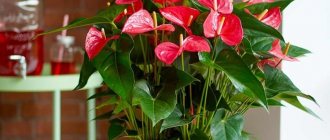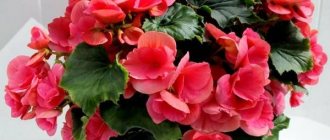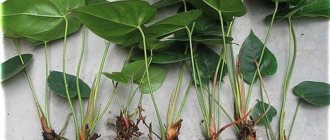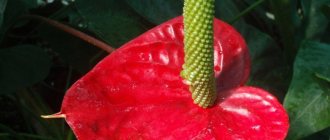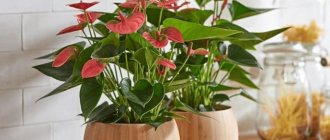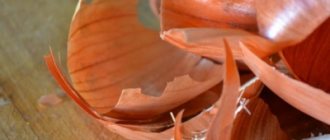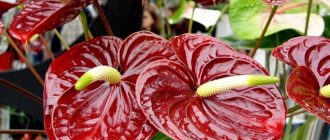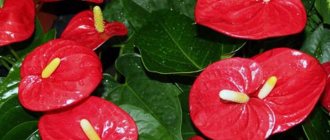In this article you will learn about the conditions for caring for anthuriums at home and transplanting a young anthurium after purchase.
House Anthurium is a special plant brought to us from countries with a hot, humid tropical climate. In addition, the anthurium flower in its natural environment often grows not even on the ground, but on tree branches, using the bark as a nutrient medium. You should take all these features of anthurium into account when caring for it at home. Below we will provide brief recommendations on how to care for anthurium in summer and winter, how to water anthurium, how to properly replant anthurium and other information necessary for every anthurium grower.
After purchasing an anthurium, check the soil moisture
As soon as you receive a parcel with anthurium or buy it in a store, check the soil moisture. The shipment may take several weeks and the soil of the plant may dry out completely along the way. In stores, too, they do not always pay due attention to the plants and often dry them out or, on the contrary, flood them, so that they begin to hurt and rot. Often anthuriums brought from abroad are in transport soil (temporary), which must be replaced after purchase. If you bought an anthurium in our nursery, you do not need to change the soil, but you must water it, since when sending anthurium by mail, we deliberately do not water it for several days. A humid environment in the absence of light can provoke root rot.
Transplant technology
To correctly determine the need to replant an anthurium, you can remove the root system of the indoor flower from the pot and conduct a careful inspection. If the root system has grown greatly and tightly entwined the entire earthen ball, it means that the indoor decorative crop requires urgent replanting according to the following technology:
- prepare high-quality planting soil based on part of the substrate for growing azaleas, part of universal soil, half of crushed pine bark, a quarter of sphagnum moss, a quarter of crushed charcoal and a small amount of vermiculite;
- rinse the drainage and dry it a little, then pour it into a flower pot in a layer equal to one third of the total volume of the planting container;
- remove the root system of the plant from the old pot and remove the old soil as thoroughly but carefully as possible, then carefully rinse the fragile roots of the anthurium under warm running water;
- dilute a solution based on the drug “Fundazol” in a previously prepared container and soak the root system of the ornamental crop, cleared of soil, in the solution for about 40-45 minutes;
- check the root system of the plant before planting and carefully remove all rotten or damaged areas using a sharp and clean knife, then treat the sections with crushed activated carbon.
At the final stage of replanting, you need to pour flower soil into the prepared pot, and then place the anthurium without disturbing the natural location of the root system. Adding soil must be done carefully so as not to break the roots or shoots of the plant. The soil needs to be slightly compacted and sprayed with a solution based on copper sulfate.
How to determine when to water anthuriums
The need for watering can be easily checked by weight; if the pot is too light, then most likely the soil is completely dry. You can check it in another way, for example, stick a wooden stick into the ground or just use your finger. The anthurium needs to be watered when the soil in the pot dries out more than halfway. Follow this rule: In order not to “flood” the anthurium, the soil in the pot should dry almost completely between waterings. You can water abundantly, but be sure to drain the remaining water from the pan. Stagnant moisture at the bottom of the pot is the worst “enemy” of anthurium. Although this plant lives in hot and humid climates, its roots grow in a loose and breathable substrate, which consists of pieces of bark, small pebbles, moss, etc.
Video on how to water anthurium.
Form
As mentioned earlier, anthurium will feel most comfortable in a wide container , the diameter of which approximately corresponds to its height. It is in such pots that the root system will develop correctly and absorb sufficient moisture and nutrients. This will also contribute to the timely removal of excess water, uniform drying of the soil and access of air to the roots.
The shape of the pot itself does not matter; the anthurium will love and grow well in both a round, square or polygonal flowerpot, the main thing is that the other conditions are met.
We recommend that you familiarize yourself with the materials on fertilizing, caring for, rejuvenating and watering anthurium.
Anthurium care after purchase
After purchasing an anthurium (or receiving a parcel), do not rush to transplant it into a new pot. The plant tolerates a long road or a long stay in the store (base) very poorly. And, if after purchasing you immediately replant it, you will increase the stress state of the anthurium, its leaves will begin to turn yellow and darken, and sometimes the plant may even die. Let the anthurium stand in your home in a warm, lit place (out of direct sunlight) for a couple of weeks. Water it with settled or rain warm water, spray the leaves every day. You can’t spray flowers, they will get stained! Wipe its leaves on both sides with a damp sponge to remove dirt and bacteria. And only after 2 - 3 weeks of adaptation to the new room conditions can the anthurium be replanted.
Caring for anthurium after purchase. What conditions need to be created for anthurium at home.
Frequent errors and difficulties
Beginners in floriculture often make mistakes when growing exotic crops. When replanting anthurium, you should not choose pots that are too large. The plant will feel great, intensively growing green mass. However, it will not bloom until the root system completely fills the planting container. Even inexperienced gardeners can grow anthurium.
Caring for it does not take much time. And in order for the plant to always look luxurious, you need to periodically rejuvenate the bush by replanting it in new soil.
Transplanting anthurium into a new pot
An anthurium division purchased at a nursery needs to be replanted, since it is in a temporary container (plastic cup) and after purchase you need to prepare the soil and a permanent pot. We use a plastic cup not only because of its low cost, but also to control the adherence of the cutting. The appearance of new roots is clearly visible through the transparent walls.
Video of anthurim transplantation after purchase.
Anthurium needs to be replanted periodically as the root system grows. Until the age of five, the transplant can be performed every year, then every three years. When replanting, the roots are inspected; if there are any diseased or damaged roots, they are cut off and the sections are treated with crushed coal. For more information about transplanting anthurium, watch the video on our channel or the material in this article: Homemade anthurium: transplantation at home.
How to plant correctly: step by step algorithm
Before replanting, moisten the soil in the pot moderately - this will make it easier to remove the plant. Then begin the transplantation, performing the following steps in turn:
- When changing the container and soil, the roots of the flower are lightly shaken to get rid of the old soil.
- The seedling is placed in a new container with drainage and loose substrate, carefully straightening the root system.
- The pot is filled with fresh soil, slightly compacting it.
- After planting, the seedling is watered with settled water at room temperature.
In this case, excess moisture that has spilled out of the drainage hole must be removed immediately. The plant is placed in a well-lit place where there are no cold drafts.
Attention! A healthy anthurium that does not need to be divided and replaced with soil can be replanted using the transshipment method. In this case, it tolerates the procedure painlessly and quickly takes root.
The transfer method is convenient to use if you did not have time to transplant the indoor crop into a new container during the spring-summer period.
Soil for anthuriums
Regular soil from your garden cannot be used for anthurium. Buy special soil for aroid plants, but it’s better to make it yourself. We have an article and video on how to make soil for anthurium. But in short, you will need five components: high-moor peat, pine bark chips, perlite, charcoal and sphagnum moss. Learn more about how to make soil for anthuriums: Soil and peas for anthuriums.
Organization of transplantation
Replanting, no matter how gentle it is, is still stressful for the plant. Therefore, you need to wisely choose the time for this procedure, and choose a suitable pot and soil.
Timing
In autumn and winter, all indoor plants rest, so all manipulations at this time are carried out only if absolutely necessary. For example, if the plant is in danger of dying.
The optimal time for transplantation is spring. However, the plant can be replanted in the summer, but provided that the air temperature is not higher than 25 degrees and the weather is rainy. Replanting in dry and hot weather can destroy the flower, since its roots in such conditions absorb moisture worse than usual.
Choosing a pot
The selection of container is determined by the purpose and reason for the transplant. If the roots stick out from the holes of the pot and completely entwine the soil, then you need a container 3-4 cm larger than the previous one. You also need a larger pot if you want the plant to grow and produce young shoots. But keep in mind that it will not bloom in a large pot.
If the transfer is just planned and you want to see beautiful flowering, then the pot should be only 2 cm larger than the previous one. When planting new shoots, you will need pots with a volume of 200-300 grams.
For anthurium, the choice of container material is not important. But you definitely need sufficient drainage holes.
Before replanting, the pot must be thoroughly washed and disinfected, especially if it has already been used. This can be easily done using laundry soap, and then pour boiling water over the inside.
Soil selection
Flower shops have a wide selection of ready-made soils for anthurium. But you can prepare a suitable mixture yourself. To do this, you need to take leaf and coniferous soil, peat and sand in equal parts. If you prepare the soil yourself, do not forget to disinfect it by keeping it in the freezer for a day.
Be sure to add a layer of expanded clay drainage to the bottom of the pot. By the way, some gardeners recommend mixing the soil itself with fine expanded clay to improve breathability.
Which pot is best for anthurim?
By placing a young small anthurium in a large pot, you create a too humid environment for it; in large peas, moisture evaporates less well. Plant the anthurium in a relatively tight pot; in such conditions it will feel better and, most importantly, the tightness stimulates its flowering instead of root growth.
When replanting, choose a pot that is slightly larger than before, 2-3 cm larger in diameter. You need to choose a plastic pot with soft walls to make it easier to pull out the root ball. In addition, thin walls warm up faster and the soil in the pot dries out better; moisture does not stagnate as much as in a ceramic pot. An anthurium pot must have holes in the bottom, and there must be a tray underneath to collect residual water. After all, the soil of the anthurium does not hold moisture well; most of it flows to the bottom. That is why dried anthuriums should not be watered, but soaked in a bucket of water. By the way, be sure to drain any remaining moisture from the pan.
Drainage
To prevent excess moisture from remaining in the soil, the bottom of the pot should have holes. In addition, the bottom of the planting container must be lined with a drainage layer (1.5-2 cm) consisting of available material. For this purpose you can use:
- gravel;
- pebbles;
- small crushed stone;
- brick chips, etc.
It is advisable to add a little charcoal to this composition to disinfect the soil. This component reduces the risk of developing fungal infections that cause root rot. Activated carbon tablets perform a similar function.
Caring for anthuriums in winter
In winter, watering the anthurium should be reduced and you can even lower the temperature a little, but not below plus 18 degrees. If pots with anthuriums are placed on a windowsill in winter, make sure that the leaves do not touch the cold glass, as the anthurium may get sick. Anthurium is a shade-tolerant plant, but the plant needs a lot of light. The light should be diffused, without direct sunlight, otherwise the leaves and flowers will lose their attractive appearance. In low light, anthurium does not grow or bloom!
Transplantation during flowering
Replanting an indoor anthurium during flowering is not such a difficult undertaking and, if the technology is followed, does not negatively affect the condition of the ornamental plant itself, as well as the buds and flowers. Even anthurium that blooms profusely in summer tolerates replanting quite easily if it is carried out according to the following recommendations:
- when transplanting flowering specimens, preference should be given to carefully transferring the root system of the plant into a large pot;
- during the replanting process, the aerial roots of the anthurium need to be lightly sprinkled with soil or covered with moistened moss;
- Immediately after replanting, it is advisable to fertilize with Kornevin or Epin.
The transplanted flowering plant in a pot must be placed in a warm and bright place, with optimal performance, the most comfortable temperature and air humidity. If the technology of transplantation and subsequent care is violated, the leaves of the anthurium often turn yellow or the flowers fall off.
When will the baby anthurium bloom?
A very small anthurium plant (baby) will bloom no earlier than in three years. Consider this when choosing the size of anthuriums.
In this video you will see what an anthurium flower, which is sometimes called a male anthurium flower, looks like. The video shows the flowering of 10 varieties of anthurium.
In this video we will give advice on which pot to choose for anthuriums, including which pot is suitable for growing orchids.
Have you bought an anthurium flower or are you going to buy a male happiness flower? Be sure to first study the recommendations for caring for anthuriums at home. In this video we have collected basic recommendations for caring for anthuriums.
Advantages and features of vegetative propagation of anthurium
The main advantage of propagating anthurium by vegetative means is the ability to quickly obtain a strong plant ready to bloom. At the same time, new specimens will completely repeat the features of the parent plants, that is, neither the shape of the leaves nor the shade of the inflorescences will differ from the anthuriums already in the collection. This is extremely important if you are going to get offspring from a hybrid.
Anthuriums, in nature, for the most part, are epiphytes, quickly produce powerful aerial roots, which they use when rooting stem cuttings, lateral shoots and layering.
In addition, in the two or three years that pass between transplants, the bush grows seriously, and if you plant an anthurium flower, you can get from 2 to 5 independent plants. This measure should not be neglected, since it only benefits the anthurium and has a beneficial effect on both its growth and the quality of flowering.
Buy a rooted baby or flowering anthurium
You can buy one blooming Anthurium, depending on the variety and age of the flower, in the range from 600 to 700 rubles. A rooted shoot (baby) of anthurium can be purchased from 350 rubles. If the cost of ordered indoor flowers (plants) is 3,000 rubles or more, then we add one plant for free. The minimum amount for any purchase is 1000 rubles.
We do not send plants by cash on delivery!
For the availability of anthuriums in our nursery, see the “Anthurium Catalog” section.
When choosing anthuriums, instead of the name, you can indicate the number of the flower in the photo.
Catalog of anthuriums: photos and descriptions.
Preparatory actions
Before you start transferring the plant into a new pot, you should take care:
- pot for a particular plant ;
- about quality soil;
- about preparing drainage: it can be small pebbles, expanded clay, sea pebbles, brick chips. This natural material will be at the bottom of the pot, retaining moisture.
Which pot should I transplant the anthurium into?
When choosing a new pot, you should pay attention to the following points:
- Form. A characteristic feature of anthurium is that its roots prefer to grow not deep into the pot, but in different directions. This fact means that when choosing a new flowerpot, you should take a closer look at wide containers; for an adult flower, the optimal diameter is 25–35 cm.
- Volume. It should not be very large, since a large pot will contribute to the development of pathogenic microflora, excessive moisture of the roots and their rotting.
- Material. The optimal solution is plastic; it will allow you to create a suitable temperature regime. A clay pot can get very cold in winter and overheat in summer. However, if preference is given to a more natural material, it is worth paying attention to the fact that the walls of the pot must be covered with glaze from the inside, otherwise the roots may grow into them and the flower will suffer greatly during transplantation.
- Presence of drainage holes. They should be large, like in shipping containers. This will allow for good aeration, allowing excess water to quickly flow out and not stagnate.
If you want to start propagating a plant, you should opt for wide pots, where the anthurium will drop its “babies” and where new shoots will develop.
However, this will negatively affect the plant's flowering, which is more likely in compact and even slightly cramped pots. Important! If a pot that has already been used before is chosen for planting anthurium, it should be thoroughly washed, treated with boiling water, and then rinsed with a solution of potassium permanganate.
Soil selection and preparation
When selling a plant, it is placed in a tight shipping pot with a peat or coconut mixture, which contains a large amount of fertilizer, allowing the flower to look attractive in its pre-sale form. However, such soil can provide the plant with the substances it needs only for a period of about 2 months, and then its strength will be depleted. The natural habitat of anthurium is a forest area, where the soil is abundantly mixed with foliage and fallen tree bark.
Based on this, you should create similar soil at home:
- slightly acidic (pH 5.5–6.5);
- well permeable to moisture, that is, loose, but at the same time capable of holding a large plant;
- permeable to air.
To independently prepare planting material, you can be guided by the following proportions:
Option 1:
- leaf humus - 2 volumes;
- coarse sand - 1 volume;
- turf - 1 volume.
Option 2:
- turf - 2 volumes;
- fibrous peat - 1 volume;
- pine bark - 1 volume;
- crushed sphagnum (moss) - 1 volume.
To stock up on this natural wealth, you can go into the forest and find fallen bark and moss, which provide the soil with lightness and aeration. Fallen leaves and turf provide nutrition to the soil.
Before planting a plant, the natural soil must be disinfected to eliminate the presence of pathogenic organisms.
To do this, you can subject it to strong heat treatment:
- freeze for several days;
- bake in the oven;
- steam;
- treat with a chemical solution of fungicides or manganese.
Ready-made and correct soil for anthuriums can, of course, be purchased at a special store for agricultural goods or equipment for ornamental gardening. It contains all the necessary elements in balance.
How to apply for the purchase of anthuriums
It is advisable to send the application in writing to [email protected] We can accept applications by phone 89379684236 (Megafon) from 10.00 to 20.00 (Moscow time).
In your application, indicate the names (or numbers) of the selected anthuriums and the desired price of the plant (division size). The letter must include your full name, postal address with zip code and mobile phone number. The application is not binding; you can adjust (add or remove plants) and even refuse the order. Please note that the quantity of some varieties of anthuriums is limited. After receiving your application, we will contact you by phone to clarify the order details, cost, and delivery. After agreeing on the order, we will provide payment details (100% prepayment only) and send your plants by Russian Post, from the beginning of spring to the end of autumn, depending on the region.
Other plants:
Homemade anthuriums: description and care
Have you bought anthurium seedlings in our nursery? Be sure to read this material. In this article you will find a description of anthurium and recommendations for caring for, growing, and replanting them at home.
Anthuriums - video on care and cultivation
Watch the videos, which explain many of the problems with growing anthuriums and provide recommendations for care, watering and propagation.
Anthuriums - problems with keeping anthurium in winter
In winter, the anthurium is severely lacking in light, and therefore, due to lack of lighting at home, the leaves of the anthurium begin to turn yellow and a number of other defects appear.
Chlorosis of plant leaves
Chlorosis is most common in hibiscus and hydrangeas. If you grow them, you definitely need to know how to treat chlorosis.
Buy homemade hibiscus
In our nursery you can buy indoor hibiscus of different varieties. Hibiscus seedlings are sold in the form of rooted cuttings.
Midges, fungus gnats, aphids and whiteflies in plants
Midges, fungus gnats, aphids and whiteflies on flowers. How to get rid of them in indoor flowers and plants?
What substrate is needed for a phalaenopsis orchid?
The orchid needs to be replanted periodically. But the phalaenopsis orchid needs a certain soil. How to make a substrate suitable for replanting an orchid.
Choosing a pot and soil
A new flower pot for growing anthurium should be of such a size that the root system of the plant has sufficient space for full growth and active development. However, purchasing a flower pot that is too large will provoke stagnation of water and, as a result, rotting of the root system and the subsequent death of the indoor flower. That is why a high-quality flower pot should be wide enough, but not deep.
The best option for growing tropical indoor plants is to use flower pots made of porous clay, but it is important to take into account such a feature of the planting container as the ability of an overgrown root system to grow firmly into the porous structure of the pot, which sometimes complicates the process of replanting the plant.
For this reason, many experienced domestic flower growers recommend giving preference to plastic or glass pots, as well as pots whose inner and outer sides are made of high-quality, glazed clay. However, which planting container to prefer for growing ornamental crops must be decided only by the owner of the anthurium.
Step-by-step instructions for proper seating
- Half an hour before transplanting, you need to water the plant generously.
- Lightly tapping the walls of the pot, remove the anthurium, shaking off the substrate from the roots.
- Then comes the hardest part - untangling the fragile roots. You should resort to cutting the roots with a knife only as a last resort. All minor damage, “wounds,” are immediately sprinkled with crushed charcoal.
- Rotten, dead and dried roots are destroyed or thrown away.
- Leave the anthurium in the open air for about an hour so that the plant dries out.
- On the outside of the bush, shoots are separated from the flower.
- Pay close attention to the depth to which the roots go deep into the soil - they are very sensitive. If the roots are left exposed to air, they will dry out. This will lead to the death of the plant. The growth point always remains above the surface of the earth.

